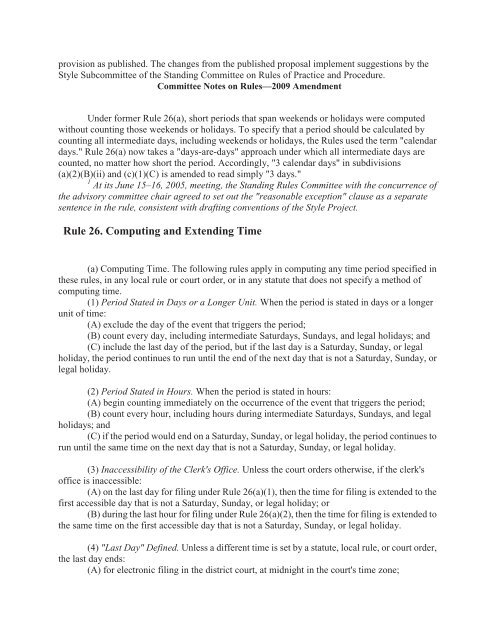Federal Rules of Appellate Procedure 2014-2015, 2014a
Federal Rules of Appellate Procedure 2014-2015, 2014a
Federal Rules of Appellate Procedure 2014-2015, 2014a
You also want an ePaper? Increase the reach of your titles
YUMPU automatically turns print PDFs into web optimized ePapers that Google loves.
provision as published. The changes from the published proposal implement suggestions by the<br />
Style Subcommittee <strong>of</strong> the Standing Committee on <strong>Rules</strong> <strong>of</strong> Practice and <strong>Procedure</strong>.<br />
Committee Notes on <strong>Rules</strong>—2009 Amendment<br />
Under former Rule 26(a), short periods that span weekends or holidays were computed<br />
without counting those weekends or holidays. To specify that a period should be calculated by<br />
counting all intermediate days, including weekends or holidays, the <strong>Rules</strong> used the term "calendar<br />
days." Rule 26(a) now takes a "days-are-days" approach under which all intermediate days are<br />
counted, no matter how short the period. Accordingly, "3 calendar days" in subdivisions<br />
(a)(2)(B)(ii) and (c)(1)(C) is amended to read simply "3 days."<br />
1 At its June 15–16, 2005, meeting, the Standing <strong>Rules</strong> Committee with the concurrence <strong>of</strong><br />
the advisory committee chair agreed to set out the "reasonable exception" clause as a separate<br />
sentence in the rule, consistent with drafting conventions <strong>of</strong> the Style Project.<br />
Rule 26. Computing and Extending Time<br />
(a) Computing Time. The following rules apply in computing any time period specified in<br />
these rules, in any local rule or court order, or in any statute that does not specify a method <strong>of</strong><br />
computing time.<br />
(1) Period Stated in Days or a Longer Unit. When the period is stated in days or a longer<br />
unit <strong>of</strong> time:<br />
(A) exclude the day <strong>of</strong> the event that triggers the period;<br />
(B) count every day, including intermediate Saturdays, Sundays, and legal holidays; and<br />
(C) include the last day <strong>of</strong> the period, but if the last day is a Saturday, Sunday, or legal<br />
holiday, the period continues to run until the end <strong>of</strong> the next day that is not a Saturday, Sunday, or<br />
legal holiday.<br />
(2) Period Stated in Hours. When the period is stated in hours:<br />
(A) begin counting immediately on the occurrence <strong>of</strong> the event that triggers the period;<br />
(B) count every hour, including hours during intermediate Saturdays, Sundays, and legal<br />
holidays; and<br />
(C) if the period would end on a Saturday, Sunday, or legal holiday, the period continues to<br />
run until the same time on the next day that is not a Saturday, Sunday, or legal holiday.<br />
(3) Inaccessibility <strong>of</strong> the Clerk's Office. Unless the court orders otherwise, if the clerk's<br />
<strong>of</strong>fice is inaccessible:<br />
(A) on the last day for filing under Rule 26(a)(1), then the time for filing is extended to the<br />
first accessible day that is not a Saturday, Sunday, or legal holiday; or<br />
(B) during the last hour for filing under Rule 26(a)(2), then the time for filing is extended to<br />
the same time on the first accessible day that is not a Saturday, Sunday, or legal holiday.<br />
(4) "Last Day" Defined. Unless a different time is set by a statute, local rule, or court order,<br />
the last day ends:<br />
(A) for electronic filing in the district court, at midnight in the court's time zone;


















